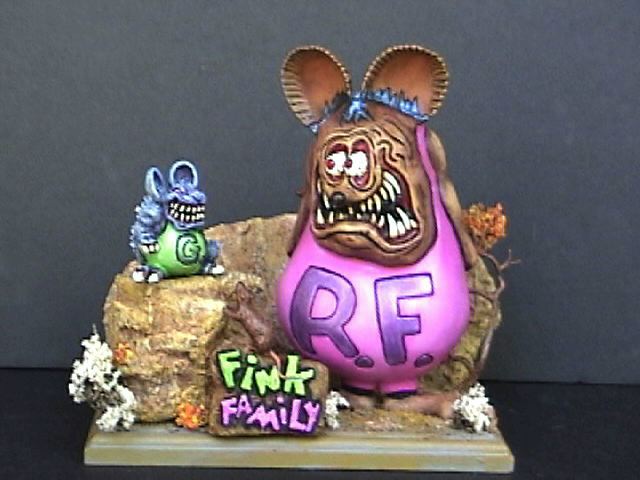

It was a marriage made in heaven, and as often happens, the acquisition of a new kit was the inspiration to revisit an old one.
First of all though, a bit of a history lesson for those people who may be scratching their heads and asking, "Rat Fink"?
THE SOURCE to turn to if you have questions about the model kits of the 60's and 70's is Rick Polizzi's CLASSIC PLASTIC MODEL KITS. In full color and in loving detail, it tells the story of all the oddball models that we old guys love, Monsters, Superheroes, Figures, Custom Cars, Space, right up to a section on really weird models called "Gadgets and Gizmos". In a section called, "Freaks, Geeks, and Oddballs", Mr. Polizzi tells the story of Ed Roth and his most famous creation.
To paraphrase Mr. Polizzi slightly, in the 1960s custom auto designer Ed
Roth was airbrushing t-shirts at custom car shows. One day, he sketched a
wild rodent on the back of a napkin to show a friend what Mickey Mouse's
true roots probably were. Roth was so happy with the character, which he
called "Rat Fink" that he transferred it to his refrigerator door at home
(the door still tours with Roth today).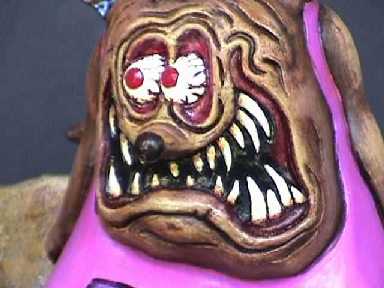
In 1962, Revell became interested in making model kits of Roth's designs. They decided they wanted a hep name for Roth. Roth suggested "Big Ed" which he had been called in school, Revell's advertising department suggested "Spider". Finally, Henry Blankfort, Revell�s PR man, came up with "Big Daddy."
History was made. The first two �Big Daddy� Roth kits sold phenomenally, and other Roth kits were released in stages, each release offered for only six months each. Brother Rat Fink, Angel Fink, Drag Nut, Fink-Eliminator . . . a plethora of kits arrived on the scene.
But the baby boomers were growing up. Rock and Roll was replacing monsters as the major fascination of the younger generation, and by 1965 kits like Outlaw with Robbin' Hood Fink and Tweedy Pie with Boss Fink sold so poorly that the series was concluded. Flash forward to the Garage Kit explosion of the late 1980s and early 1990s. One of the most talented and creative Garage Kit creators around is Mike Parks, who runs Mad Lab Models. Mike has created many "ordinary" figure sculpts, vampire women, a Harryhausen Cyclops, and King Kong fighting a serpent. But Mike's real gift is imagining things that other Garage Kit producers have never dreamt of. He was one of the first to offer custom wall-plaques (a FAMOUS MONSTERS OF FILMLAND TRIBUTE), and has a diminutive "Creature plaque" with a 3 inch creature head mounted like a prize bass. He created custom bases for kits in the Billiken series that came without Aurora-style bases, and was one of the first sculptors doing busts of famous characters. But most endearing and influential was a series of kits called TINY TERRORS, four inch resin parody kits of famous film characters.
Mike claims that he wants to sculpt at least 100 different TINY TERRORS. They're a fascinating series for their humor (Many people will have seen his Godzilla with arms raised in vexation, and squashed human annoying stuck to the underside of his foot.). But the TINY TERRORS are also fascinatingly detailed - for example, Mike's kit of Boris Karloff as Frankenstein accurately depicts Boris in make-up designed by Jack P. Pierce but never used in the film.
What appeals to me most about Mike's work, in this age of high-priced resin Garage kits, is the fact that he has obviously thought long and hard about ways to provide an entertaining and satisfying model kit that is small enough for the ordinary mortal to afford. The TINY TERRORS are $15.00, plus $3.50 postage.
However, that wasn�t enough. Mike is now sculpting SUPER TINY TERRORS, kits 1 1/2 to 2 inches high, each one with a simple base. These kits retail for $5.00 plus $3.50 postage.
The best news for we G-Fans is that Mike is inordinately fond of sculpting Godzilla parodies.
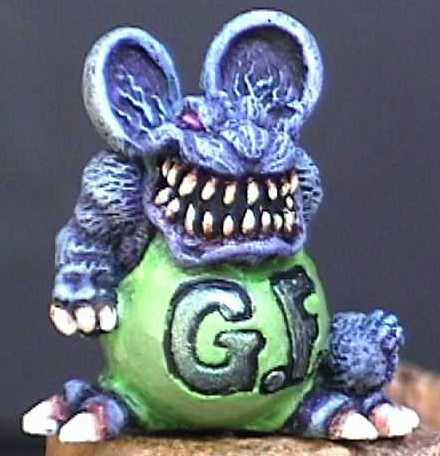 Over the years, Mike produced his TINY TERROR Godzilla, and a Paint cup in
the shape of Godzilla's foot on a squashed Bambie . . . but it's with the
SUPER TINY TERRORS that Mike really went nuts. There's a SAMURAI GODZILLA!
There's a SUMO GODZILLA! There's one Godzilla that looks like he can�t
find
a bathroom, another Godzilla fighting to avoid being dragged away by Mothra
. . .
Over the years, Mike produced his TINY TERROR Godzilla, and a Paint cup in
the shape of Godzilla's foot on a squashed Bambie . . . but it's with the
SUPER TINY TERRORS that Mike really went nuts. There's a SAMURAI GODZILLA!
There's a SUMO GODZILLA! There's one Godzilla that looks like he can�t
find
a bathroom, another Godzilla fighting to avoid being dragged away by Mothra
. . .
You get the idea. Godzilla crazy!
Which leads us to the G-Fink.
I decided that the concept was a diorama of the FINK FAMILY, well, at least two brotherly Finks. I hope to find an even smaller one eventually - Rat Fink Jr. - in the shape of an old plastic keychain figure).
The first problem was that the G-FINK was much smaller than the Rat Fink. (I assumed that this WASN'T A SCALE problem . . . G-Fink just is a little short person . . .er, monster . . . er, whatever . . .)
The problem was, how to put the two Finks eyeball to eyeball.
Luckily, this problem tied in to one of the adventures of diorama creation. Just what kind of a scene was I going to create? Where did Rat Finks hang out?
Well, custom car shows and dragstrips obviously . . . but I didn't want cars to take impact away from the figures (after all, I had already built that GODZILLA�S GO-CART). Ed "Big Daddy" Roth lives in Utah . . . and it occurred to me that Utah, with it's rugged and beautiful deserts, was the kind of place that you might find a Rat Fink. Better yet, the geology of a badlands/desert area could give me an excuse for getting G-FINK eye-to-eye with his older brother. I'd build a tall column of rock - a "hoodoo" - for the little guy.
Ultimately I decided on three slabs of "rock". One at the back of the display base to define the space, a hoodoo for G-Fink, and a smaller slab to be used as a name plate. My friend Larry Brackney had shown me how to create incredible bases by carving balsa foam and then soaking it in resin to create a solid but light-weight diorama base. I didn�t have either balsa foam or liquid resin around the house . . . but I did have some cheap alternatives.
I took florist's foam, the dense foam that is used to create flower displays, and cut out basic slabs of "rock". Once I had carved out the basic shape (saving any scrap that was created in the process), I sculpted them with a set of rasps, scraping away foam to form cracks and ridges. Florist�s foam is much more fragile than balsa foam, and I wouldn't recommend it for a really elaborate carved shape, but it works fine for rocks and basic landscape detail. I cut a slab the length of the display base for the back of the diorama. Then I cut a few more pieces and, combining them with the scraps, I used white glue and metal pins (cut copper or brass tubing is fine - and available in most hobby stores) to build up the "hoodoo".
 Okay, I had the basic shapes but not resin to coat them with. However, I
always keep plaster bandage around the house. Plaster bandage is easy to
use, and an advantage for young people is that it�s not nearly as
complicated as working with liquid resin, which is toxic and must be used
with proper ventilation.
Okay, I had the basic shapes but not resin to coat them with. However, I
always keep plaster bandage around the house. Plaster bandage is easy to
use, and an advantage for young people is that it�s not nearly as
complicated as working with liquid resin, which is toxic and must be used
with proper ventilation.
I'd recommend a dust mask when cutting plaster bandage, as a lot of fine dust is produced. Simply cut multiple strips, get them slightly damp, apply them to the shaped foam and use your fingers to smooth out the plaster. For the back of the diorama, I cut the strips long enough that they not only covered the rock but spread out onto the display base where they could be shaped for ground texture. For the "hoodoo", I applied the plaster bandage over the multiple pieces of foam to create the impression of different layers of weathered rock.
The plaster bandage dries very quickly, which is another plus. (By the way, if you find hard, "chunky" little bits in your plaster bandage, it means that you have been splashing water around the bandage. Water is the agent that activates the plaster and once it has gotten wet it will solidify.)
The bandage is made by impregnating a piece of cloth with plaster, and the weave of the cloth may show. (This can be an advantage - representing, say, a wire frame within a concrete wall). In this case, I used my all-purpose hobby material, Liquitex acrylic modeling paste. I use modeling paste as a filler on kits, rubbing it into cracks and then wiping away the excess with wet q-tips or paper cloth. But in this case, I was using the modeling paste to smooth over the folds and wrinkles I had created with the bandage, covering the understructure of the bandage and creating more texture.
I textured the paste with a variety of sculpting tools - but at a pinch you can easily make a sculpting tool out of old chopsticks or vegetable skewers. Chopsticks can even be formed into a small spatula by carving a depression in one end with your hobby knife.
The modeling paste takes a little longer than the plaster bandage to set, but in about three hours - Voila! - the desert home of the Finks.
Although I had painted the Fink's skin tones "realistically" - I used bright colors on their clothing to give the kit a kind of 60's fluorescent color feel, buffing the initials on their clothing with Liquitex iridescent colors over black - violet for Rat Fink, and green for G-Fink. Though I had painted the rock a series of "limestone" browns and yellows, drybrushing from dark to light, and breaking this up with darker washes . . . I wanted to carry the bright colors into a few other areas in the scene.
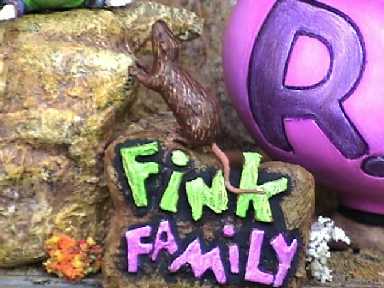 The "Fink Family" name plate was created with foam and plaster bandage, but
the letters were cut from foam-core. (Foam-core is a mounting paper with a
styrofoam core, and comes in a variety of thickness'. It is good for
creating relief lettering, although you can also use the thicker grades of
styrene plastic sold at hobby stores. Styrene is somewhat easier to cut.)
The "Fink Family" name plate was created with foam and plaster bandage, but
the letters were cut from foam-core. (Foam-core is a mounting paper with a
styrofoam core, and comes in a variety of thickness'. It is good for
creating relief lettering, although you can also use the thicker grades of
styrene plastic sold at hobby stores. Styrene is somewhat easier to cut.)
After I had cut out my letters and glued them to my "rock", I covered them with modeling paste too. This allowed me to work the paste all around them - disguising their "white foam centers" and also allowing me to create a little bit of texture on their surface. I finished the "name plate" off by using the same green and violet as the Finks were wearing, and then using a dark shading behind the letters to heighten the relief.
For desert plant life, I found some twigs in the backyard garden and glued different colors of foam - white and orange - to them. There is a wide variety of foam chips available from model shops (especially model railroad stores) and craft stores. More realistic tans and greens are easily available, but I like the accent of color created by the bright oranges and white.
Finally, I went to the closet and got out the Polar Lights reissue of the Aurora Monster Customizing kit. I was looking for a couple of plastic rats, but I also came away with a dead tree . . . just the things to finish off the kit and emphasis that "60's" feel.
Dioramas create emotional impressions by telling stories. What impressed me about G-Fink was that he was - if possible - even more demonic -looking, with his toothy grin and beady little eyes, than the original Rat Fink.
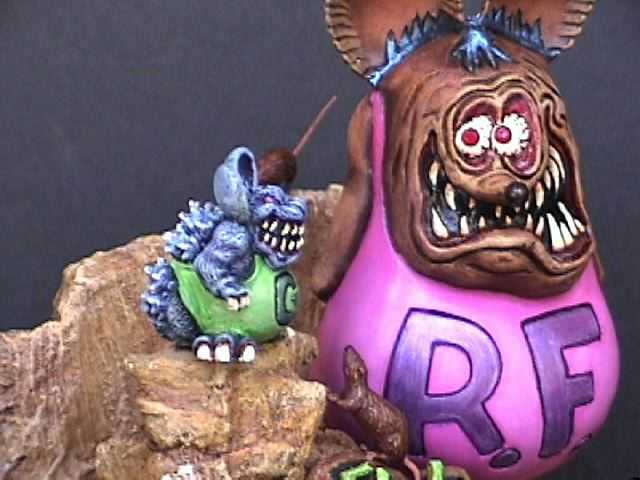 In fact, beside G-Fink, Rat Fink looked positively frightened.
In fact, beside G-Fink, Rat Fink looked positively frightened.
I decided the focus of the kit would be G-FINK (well, after all, I AM a G-FAN), so after placing G-Fink on his "hoodoo", I experimented with positions for Rat Fink. With his eyes popping crazily to the right, it wasn�t hard to find the right, expressive "eye line". G-Fink and his rock got placed on the right, Rat Fink - looking worried and expectant - on the left. To heighten this effect, I made sure the rats were also looking at G-Fink, making him the center of attention by having one rat staring at him from the top of the name plate and the other looking at him from the back of the diorama. Now, from just about position on the base, the "eye lines" show you which character you should be worried about.
What's G-Fink going to do to Rat Fink? Is a brotherly spat about to begin?
Who will survive and what will be left of them?
I leave that to the viewer�s imagination.
Mike Park�s kits are available from X-O FACTO or from Mike
MAD LAB MODELS,
869 Northwest Blvd.
Columbus OH 43212 614-299-6509
Catalog of (over 90) products - $2.00
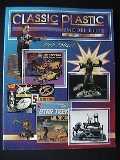 CLASSIC PLASTIC MODEL KITS: Identification and Value Guide
CLASSIC PLASTIC MODEL KITS: Identification and Value Guide
$ 24.95
by Rick Polizzi
Published by Collector Books: a Division of Schroeder Publishing Co. Ltd.
ISBN 0-89145-701-1
BEST STan
 Back to the Stan's Kaiju Korner
Back to the Stan's Kaiju Korner